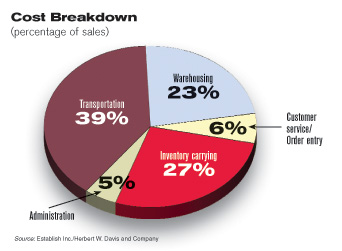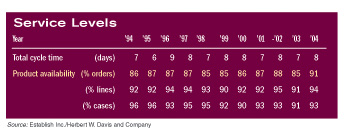BEFORE ADDING SPACE — or even thinking about adding space — to your distribution facility, your first thought in these budget-constrained times is most likely to be about what the whole process will cost. It is important to keep in mind, however, that although cost control is a critical aspect of operational management, it should not take precedence over desirable outcomes such as improved customer service, greater logistical efficiency, or faster response times.

Before deciding how to allocate your precious dollars, take a look at “Logistics Cost and Service 2004,” a report presented by Establish Inc./Herbert W. Davis and Company, a Fort Lee, NJ-based logistics and supply chain consulting firm, at the Council of Logistics Management’s annual conference in October. The report revealed that for the average company, the total cost of logistics in 2004 remained about the same as it was in 2003 — an unusual pattern that last occurred between 1992 and 1995. In 2004, cost as a percentage of sales fell only 0.4%, and cost per hundredweight dropped 4.2%. According to Establish Inc., just 46% of the firms in its database were able to reduce their costs in 2004, a number significantly lower than in previous years. For the total sample of companies, sales rose 5.75% and product value climbed 6.73%; weight declined 0.91% and costs fell 2.27%. While the smaller shipping load drove down expenses, logistics costs probably decreased less than they should have because of higher wages, energy costs, taxes, and so forth.
SOFT SERVE
Another finding of the study was that customer service levels are not improving, although service trumps costs as the strongest force driving logistics decisions. The Establish Inc. survey defines customer service as “the prompt and complete delivery of goods ordered.” Average performance on each of several standard measures hasn’t changed markedly in the past ten years, as the table below shows.
When you analyze your DC’s expected performance and figure out what your operating expenses are likely to be, consider the survey respondents’ answers to questions about their logistics strategies and perspectives. Keeping their overarching concerns in mind can help you decide what your priorities should be and which logistics activities should benefit from the bulk of your budget. The following, for instance, are what the respondents consider the most pressing issues in operating logistics functions:
- Reducing costs
- Problems in the physical process
- Supply chain coordination
- Personnel problems
- 3PL capabilities and roles
- IT solutions
- Carrier capacity
Respondents’ most pressing issues in managing logistics are as follows:
- Integrating supply chain components
- Meeting service requirements
- Personnel
- Costs and service
- Selling the value of logistics
- Excess capacity in manufacturing and distribution
- Decentralized company and logistics functions
SPIN CYCLE
Their most difficult customer requirement, the Establish Inc. survey respondents say, is shortening cycle times. Other problematic areas are fulfilling special requirements, fill rates and availability, on-time delivery, next-day delivery, visibility, and value-added processing.

Recent changes to the respondents’ logistics networks include such activities as downsizing (20%) and adding new DCs (13%). Some of the companies surveyed have recently changed their support systems by adding a transportation management system, a warehouse management system, or an enterprise resource planning system.
The Establish Inc. survey results reveal two different 2004 scenarios, one typically exhibited by consumer companies and the other by industrial firms. The consumer companies, the survey shows, have recovered from sales and volume slumps and can cover rising logistics costs with revenue from increasing sales; they have the freedom to try out new initiatives and make capital expenditures.
The industrial enterprises, on the other hand, continue to be faced with steady or decreasing sales and volume. These companies cannot, therefore, cope with logistics cost increases and are forced to control costs by imposing rigorous spending limits, staying away from new ventures, and firmly restricting capital expenditures.
The survey researchers suggest the following ways to implement a balanced strategy: Know your costs and service levels; understand where your operation stands in comparison to your industry and other industries; place tight controls on logistics regardless of whether your sales are up or down; and improve and capitalize your business on a constant basis.
Add Value, Says Expert
Rama Ramaswami is editorial director of Operations+Fulfillment.
Your operation, like many others, may still be in cost-cutting mode. But there are signs that the days of truly stringent budgets are over, says William Drumm, president and CEO of Establish Inc./Herbert W. Davis and Company, a supply chain and logistics consulting firm based in Fort Lee, NJ. “At this point in the economic cycle, it makes sense to ask what you need to do to serve your customer base rather than save a nickel,” he says.
If you’re thinking of leasing or buying more DC space, adds Drumm, what you’ll be doing in the new building is providing more value-added services: “If the economy strengthens, does that mean that adding value and improving customer service are reasons to justify improvements in logistics? The answer is yes.”
As for must-have modifications to your facility, Drumm cites two right off the bat. The first consideration, he says, is to analyze what you’re doing with your WMS.
“Are you using your warehouse management system to its fullest potential in managing the warehouse?” he asks. “There is a difference between running the warehouse and managing the warehouse. Transaction systems help you get the shipments out the door, print pick lists, and so forth. But does the WMS allow you to do the ‘M’ — the management?”
The second imperative, Drumm says, is to “use the facility correctly on a multi-shift basis.” Most warehouses do not operate efficiently around the clock, he says, suggesting that the key to getting more out of a facility is to use it in what are now called “off-hours.”— RR